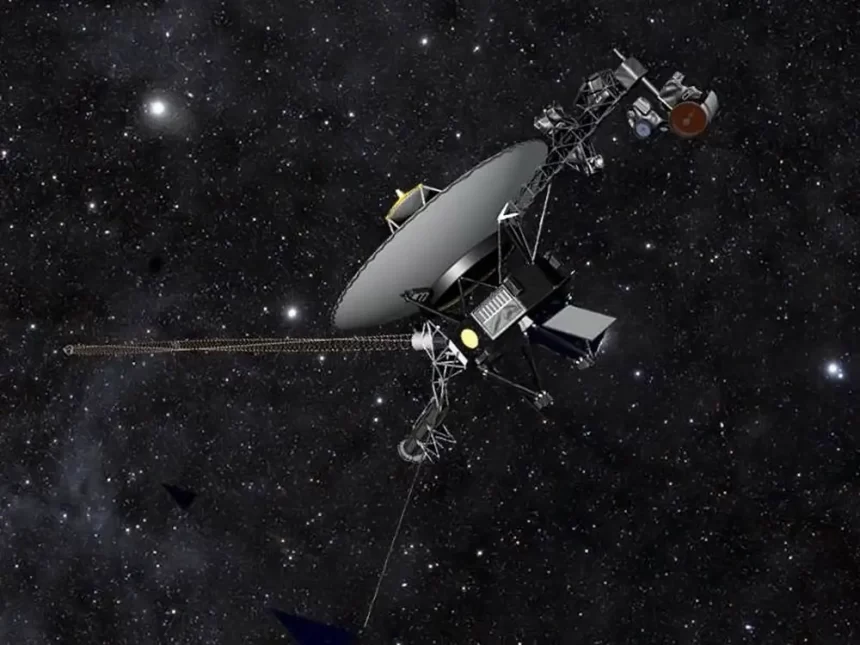The wonders of space exploration continue to surprise and inspire us even after decades of missions. One of the most remarkable achievements in this field is the NASA’s Voyager 1 spacecraft has been exploring interstellar space for 45 years, collecting data and breaking barriers.
Launched in 1977 to fly by Jupiter and Saturn, it surpassed expectations and became the first spacecraft to enter interstellar space in 2012. A tribute to human curiosity and the desire to explore the unknown. Voyager 1 was the first spacecraft to cross the heliosphere, the boundary where the influences outside our solar system are stronger than those from our Sun.
In 1977, Voyager 1 surpassed Voyager 2 due to a faster route and exited the asteroid belt earlier. It began its mission to capture images of Jupiter in April 1978, when it was approximately 165 million miles (265 million kilometers) away from the planet.
The images sent back in January 1979 indicated that Jupiter’s atmosphere was more tempestuous than during the Pioneer flybys in 1973-1974. From January 30 to February 2, 1979, Voyager 1 took a picture every 96 seconds for 100 hours to generate a color time-lapse movie that illustrated 10 rotations of Jupiter.
One of the most intriguing findings was on Io, where the images showed a strange yellow, orange, and brown world with at least eight active volcanoes emitting material into space. This made Io one of the most geologically dynamic planetary bodies in the solar system.
The existence of active volcanoes signifies that the sulfur and oxygen in Jovian space may be a result of the volcanic plumes from Io, which are rich in sulfur dioxide.
READ MORE: SpaceX Dragon Launches Four Astronauts to ISS
Jupiter Achievements

Voyager 1 thoroughly explored Jupiter, including its magnetosphere and moons, and surpassed the accomplishments of its predecessor, the Pioneer spacecraft. The only exception was the failure of Voyager 1’s photopolarimeter experiments.
The mission’s findings ushered in a revision of earlier atmospheric models, as the spacecraft discovered that Jupiter’s atmosphere was more active than previously thought. Voyager 1 also provided exceptional images of the terrain of Jupiter’s moons, including Amalthea, Io, Europa, Ganymede, and Callisto.
Perhaps the most astonishing discovery was the incredibly active volcanoes on Io, which are powered by the moon’s elliptical orbit around Jupiter. This revolutionary finding questioned existing theories about the outer planets’ moons.
Moreover, the spacecraft detected a thin ring around Jupiter, making it the second planet known to have a ring, and discovered two new moons, Thebe and Metis.
Saturn Achievements

Saturn was explored in greater detail by Voyager 1, the second spacecraft to visit the planet. Its mission included examining Saturn’s moons, magnetic fields, and rings, which was not achievable with its predecessor, Pioneer 11.
All of Voyager 1’s goals were met except for the photopolarimeter experiments which failed to function. Three new moons, Prometheus, Pandora, and Atlas, were discovered by the spacecraft.
Titan, Saturn’s largest moon, has a dense atmosphere that obscures its surface from visible-light cameras and telescopes. Its atmosphere is mostly nitrogen, like Earth’s atmosphere, but has a surface pressure 1.6 times higher than ours. The spacecraft also captured images of Mimas, Enceladus, Tethys, Dione, and Rhea moons.
Voyager 1 revealed the delicate structures of Saturn’s complex and beautiful ring system and added the G ring to the list of known rings. Voyager 1 also used Saturn’s gravity to increase its speed and change its course, giving it a trajectory to leave the solar system.
Interstellar Accomplishments
Voyager 1 executed a historic accomplishment in August 2012 by becoming the first spacecraft to enter interstellar space. However, according to our definition of the solar system as everything mainly orbiting the Sun, Voyager 1 will continue to exist within the solar system until it emerges from the Oort cloud, which is estimated to happen in approximately 14,000 to 28,000 years.




